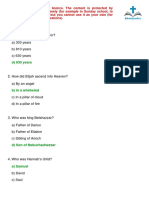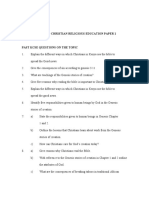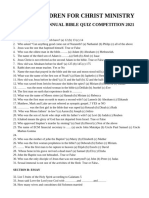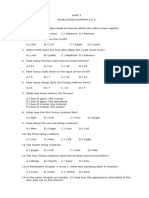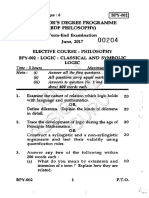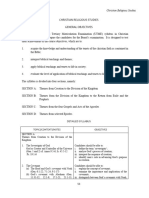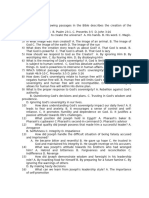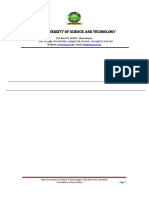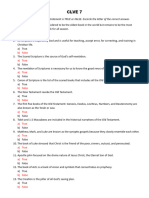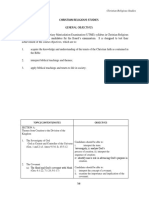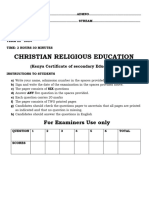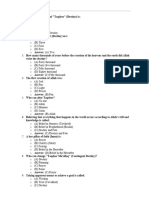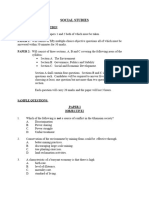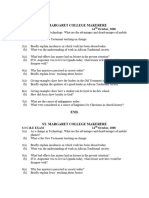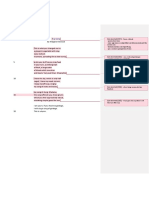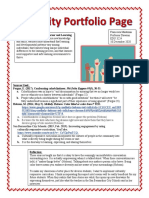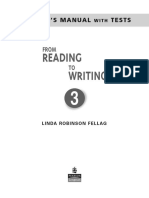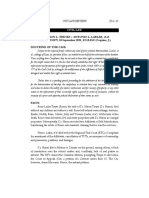Ughe's Assignment
Ughe's Assignment
Uploaded by
samin usmanCopyright:
Available Formats
Ughe's Assignment
Ughe's Assignment
Uploaded by
samin usmanOriginal Title
Copyright
Available Formats
Share this document
Did you find this document useful?
Is this content inappropriate?
Copyright:
Available Formats
Ughe's Assignment
Ughe's Assignment
Uploaded by
samin usmanCopyright:
Available Formats
MATRIC NUMBER: PGDE/PT/22/0094
NAME: UWANDU OGECHI PATRICIA
COURSE TITLE: MEASUREMENT AND EVALUATION
COURSE CODE: PGDE 723
TASK: ASSIGNMENT
QUESTIONS:
1. Explain the term TABLE OF SPECIFICATIONS.
2. In your area of study using any topic of your choice, construct a table of specifications with a 50 item objective
questions, write out the questions and the marking scheme.
ANSWERS:
1. TABLE OF SPECIFICATIONS:
It is a comprehensive valid measure used by a teacher to ensure high content validity when setting test questions.
A Table of specifications serves as a guide for the teacher, ensuring the test is comprehensive, systematic and aligned
with the lesson objective.
A Table of specifications can be defined as a two-way table that shows the lists of topics covered by a teacher on a table
along the rows and also relaying the levels of objectives along the column.
In a simple term, a table of specification is a detailed outline of a testing strategy and plan with defined scope,
objectives and structure of a testing process.
2. TABLE 1.1 TABLE OF SPECIFICATIONS FOR A TEST IN SECURITY EDUCATION.
CONTENTS OBJECTIVES
TOPICS KNOWLEDGE COMPREHENSION APPLICATION TOTAL
The Supremacy of God at Mount Carmel 4 4 2 10(20%)
Israelites in Bondage 4 4 2 10(20%)
Saul as King 4 4 2 10(20%)
Eli and his sons 4 4 2 10(20%)
The story of Jacob 4 4 2 10(20%)
TOTAL 20 20 10 50
(40%) (40%) (20%) (100%)
The Table of specifications in Table 1.1 shows that the test would be made up of 50 test items. 40% (20 items) would
measure knowledge, 40% (20 items) would measure comprehension, while 20% (10 items) would measure Application.
The total column by the right indicates the number of items to be developed on the basis of five (5) topics in the
content of instruction.
The questions and marking scheme are as follows:-
TOPIC: The Supremacy of God at Mount Carmel
Knowledge (4 questions):
1. Who was the prophet who challenged the prophets of Baal at Mount Carmel? a) Elijah b) Elisha c) Isaiah
d) Jeremiah
2. What was the name of the pagan god whose prophets Elijah challenged at Mount Carmel? a) Baal b)
Asherah c) Molech d) Dagon
3. How many prophets of Baal were present at Mount Carmel? a) 400 b) 450 c) 500 d) 550
4. What was the outcome of the contest between Elijah and the prophets of Baal at Mount Carmel? a) The
prophets of Baal won b) Elijah won c) It was a draw d) The contest was cancelled
Comprehension (4 questions):
5. What was the purpose of Elijah's challenge to the prophets of Baal at Mount Carmel? a) To prove the
supremacy of God b) To prove the power of Baal c) To show the weakness of the Israelites d) To
demonstrate the futility of idol worship
6. How did Elijah's actions at Mount Carmel demonstrate his trust in God? a) He prayed for rain b) He called
down fire from heaven c) He sacrificed a bull d) He trusted God to provide the outcome
7. What was the significance of the fire consuming the sacrifice at Mount Carmel? a) It showed the power of Baal
b) It demonstrated the weakness of the Israelites c) It proved the supremacy of God d) It was a coincidence
8. How did the Israelites respond to Elijah's victory at Mount Carmel? a) They turned back to God b) They
continued to worship Baal c) They were indifferent d) They persecuted Elijah
Application (2 questions):
9. What can we learn from Elijah's boldness and trust in God at Mount Carmel? a) To trust in ourselves b) To
trust in our own abilities c) To trust in God's sovereignty d) To fear man rather than God
10. How can we apply the lesson of Mount Carmel in our own lives? a) By compromising with the world b) By
standing firm in our faith c) By fearing man rather than God d) By trusting in our own abilities
TOPIC: Israelites in Bondage
Knowledge (4 questions):
11. Who was the Pharaoh who enslaved the Israelites in Egypt? a) Ramses II b) Pharaoh Akhenaten c)
Pharaoh Shishak d) Pharaoh Solomon
12. How long were the Israelites in bondage in Egypt? a) 200 years b) 400 years c) 500 years d) 600 years
13. What was the name of the Israelite who was forced to make bricks without straw? a) Moses b) Aaron
c) Joseph d) Joshua
14. Which book of the Bible records the story of the Israelites' bondage in Egypt? a) Genesis b) Exodus c)
Leviticus d) Deuteronomy
Comprehension (4 questions):
15. Why did the Pharaoh enslave the Israelites? a) Because they were a threat to his power b) Because they
were a large and growing population c) Because they were idol worshipers d) Because they were lazy
16. How did the Israelites' bondage in Egypt affect their relationship with God? a) It strengthened their faith b)
It weakened their faith c) It had no impact on their faith d) It led to their rejection of God
17. What was the purpose of the Israelites' bondage in Egypt? a) To punish them for their sins b) To prepare
them for the Promised Land c) To teach them a lesson d) To destroy them
18. How did the Israelites' bondage in Egypt foreshadow their future redemption? a) It showed them the power of
God b) It demonstrated the need for a savior c) It prepared them for the coming of Jesus d) It had no
connection to their future redemption
Application (2 questions):
19. What can we learn from the Israelites' experience in bondage about God's plan for our lives? a) That He wants
us to suffer b) That He wants us to be in control c) That He has a plan to prosper us d) That He is
indifferent to our struggles
20. How can we apply the lesson of the Israelites' bondage in our own lives when we face difficult circumstances? a)
By giving up and losing hope b) By trusting in God's sovereignty c) By trying to escape our problems d) By
blaming others for our struggles
TOPIC: Saul as King
Knowledge (4 questions):
1. Who was the first king of Israel? a) Saul b) David c) Solomon d) Samuel
22. What was the name of Saul's father? a) Kish b) Abner c) Samuel d) Jonathan
23. Which tribe was Saul from? a) Benjamin b) Judah c) Ephraim d) Manasseh
24. How long did Saul reign as king of Israel? a) 20 years b) 30 years c) 40 years d) 50 years
Comprehension (4 questions):
25. Why did the Israelites demand a king? a) Because they wanted to be like other nations b) Because they were
dissatisfied with God's leadership c) Because they wanted a human leader to trust in d) Because they were tired
of Samuel's leadership
26. What was Saul's major weakness as king? a) His lack of faith in God b) His disobedience to God's commands
c) His fear of the people d) His lack of leadership skills
27. How did Saul's reign as king end? a) He died in battle b) He was rejected by God c) He became a
prophet d) He retired and handed over the kingdom to David
28. What was the significance of Saul's rejection as king? a) It showed that God was unhappy with the Israelites
b) It demonstrated the importance of obedience to God c) It marked the beginning of the Davidic dynasty
d) It had no significant impact on Israel's history
Application (2 questions):
29. What can we learn from Saul's experience about the importance of obedience to God? a) That it is optional
b) That it is necessary for success c) That it is only for spiritual leaders d) That it is not relevant today
30. How can we apply the lesson of Saul's rejection in our own lives when we face decisions and challenges?
a) By trusting in our own abilities b) By seeking God's guidance and wisdom c) By following the crowd d)
By doing what we think is right
TOPIC: Eli and his Sons
Knowledge (4 questions):
31. Who was the high priest of Israel during the time of Samuel's youth? a) Eli b) Phinehas c) Hophni
d) Samuel
32. What were the names of Eli's sons? a) Hophni and Phinehas b) Samuel and John c) David and
Jonathan d) Absalom and Amnon
33. What was the office held by Eli and his sons? a) King b) Prophet c) Priest d) Judge
34. Where did Eli and his sons serve as priests? a) Shiloh b) Jerusalem c) Bethlehem d) Hebron
Comprehension (4 questions):
35. What was the problem with Eli's sons, Hophni and Phinehas? a) They were too young to serve as priests
b) They were not from the tribe of Levi c) They were corrupt and disobedient d) They were not experienced
enough
36. How did Eli respond to his sons' wrongdoing? a) He rebuked them strongly b) He ignored their behavior
c) He warned them gently d) He replaced them with other priests
37. What was the consequence of Eli's failure to discipline his sons? a) The Israelites lost trust in the priesthood
b) The Philistines defeated the Israelites c) Eli's family lost the priesthood d) Samuel was not able to
become a prophet
38. What did Eli's story teach about leadership and accountability? a) That leaders are not responsible for their
team's actions b) That leaders should prioritize their family over their responsibilities c) That leaders are
accountable to God for their actions and those they lead d) That leaders should not confront wrongdoing
Application (2 questions):
39. What can we learn from Eli's failure to discipline his sons about our own leadership and parenting responsibilities?
a) That we should prioritize our own interests over our responsibilities b) That we are not accountable for the
actions of those we lead or parent c) That we must take responsibility for guiding and correcting those in our care
d) That we should ignore wrongdoing and hope it goes away
40. How can we apply the lesson of Eli's story in our own lives when we see wrongdoing or corruption? a) By
ignoring it and hoping someone else addresses it b) By confronting it directly and taking action to stop it c)
By reporting it to someone in authority d) By participating in it since everyone else is doing it
TOPIC: The Story of Jacob
Knowledge (4 questions):
41. Who was Jacob's father? a) Abraham b) Isaac c) Joseph d) Esau
42. What was the name of Jacob's twin brother? a) Esau b) Joseph c) Benjamin d) Judah
43. What did Jacob trick Esau out of? a) His birthright b) His blessing c) His inheritance d) His name
44. Who did Jacob wrestle with at the Jabbok River? a) Esau b) Laban c) An angel of God d) A stranger
Comprehension (4 questions):
45. Why did Jacob flee from Esau? a) Because he was afraid of Esau's wrath b) Because he wanted to escape his
responsibilities c) Because he wanted to find a wife d) Because he was called by God
46. What did Jacob's dream at Bethel signify? a) His desire to return to Canaan b) His fear of Laban's wrath
c) God's promise to be with him d) His own cleverness
47. How did Jacob's relationship with Laban change over time? a) It became more trusting and friendly b) It
remained the same c) It became more distant and tense d) It was always hostile
48. What was the significance of Jacob's name change to Israel? a) It marked a new beginning for him b) It
signified his victory over Esau c) It represented his new identity as a leader d) It was a punishment from God
Application (2 questions):
49. What can we learn from Jacob's story about perseverance and trust in God? a) That we should give up when
things get difficult b) That we should rely on our own strength and cunning c) That we should trust in God's
promises and provision d) That we should only pray when things are going well
50. How can we apply the lesson of Jacob's story in our own lives when we face challenges and uncertainties? a)
By running away from our problems b) By trying to manipulate and control our circumstances c) By seeking
God's guidance and trusting in His sovereignty d) By blaming others for our struggles
MARKING SCHEME:
1. Answer: a) 2. Answer: a) 3. Answer: b) 4. Answer: b) 5. Answer: a) 6. Answer: d)
7. Answer: c) 8. Answer: a) 9. Answer: c) 10. Answer: b) 11. Answer: a) 12. Answer: b)
13. Answer: a) 14. Answer: b) 15. Answer: b) 16. Answer: b) 17. Answer: b) 18. Answer: b)
19. Answer: c) 20. Answer: b) 21. Answer: a) 22. Answer: a) 23. Answer: a) 24. Answer: b)
25. Answer: a) 26. Answer: b) 27. Answer: b) 28. Answer: b) 29. Answer: b) 30. Answer: b)
31. Answer: a) 32. Answer: a) 33. Answer: c) 34. Answer: a) 35. Answer: c) 36. Answer: b)
37. Answer: c) 38. Answer: c) 39. Answer: c) 40. Answer: b) 41. Answer: b) 42. Answer: a)
43. Answer: a) 44. Answer: c) 45. Answer: a) 46. Answer: c) 47. Answer: c) 48. Answer: c)
49. Answer: c) 50. Answer: )
You might also like
- Theory 3, 2024 Qs AloneDocument1 pageTheory 3, 2024 Qs AloneadeoluwafunmikeogundeleNo ratings yet
- 50 Questions: D) 930 YearsDocument12 pages50 Questions: D) 930 Yearsfasilumar7890No ratings yet
- 101 Islamic IdeologyDocument7 pages101 Islamic IdeologyRehenaPurvinNo ratings yet
- Advance Level Religious Studies 1st Term ExamsDocument9 pagesAdvance Level Religious Studies 1st Term ExamsJevkin WoloaNo ratings yet
- Helen WPS OFFICE-1-1-1Document6 pagesHelen WPS OFFICE-1-1-1brightokechukwu602No ratings yet
- Loyalty To God. Elijah QDocument2 pagesLoyalty To God. Elijah Qnicholas.ropc95No ratings yet
- Form 4 Assignment Loyalty To GOD: ELIJAHDocument2 pagesForm 4 Assignment Loyalty To GOD: ELIJAHsandieNo ratings yet
- West African Council Mock Examination On Crs Class: Ss 3 ObjectivesDocument3 pagesWest African Council Mock Examination On Crs Class: Ss 3 Objectivesvictor ifeanyiNo ratings yet
- CRS SeniorDocument6 pagesCRS Seniorbright bolaNo ratings yet
- Form One Work Chapter One Introduction To Christian Religious Education Paper 1Document394 pagesForm One Work Chapter One Introduction To Christian Religious Education Paper 1chaniaNo ratings yet
- S.6 CRE p.245-1Document1 pageS.6 CRE p.245-1Eremu Thomas100% (1)
- 10 - Aqad 09-11-2024Document1 page10 - Aqad 09-11-20242392riteshsarkarNo ratings yet
- C.R.E Topical QSDocument387 pagesC.R.E Topical QSvollleybillNo ratings yet
- THCRS SS 2Document3 pagesTHCRS SS 2victoria raymondNo ratings yet
- Children For Christ Ministry QUIZDocument2 pagesChildren For Christ Ministry QUIZiliyajaphet66No ratings yet
- S6 C.R.E P1 Revision Past PapersDocument2 pagesS6 C.R.E P1 Revision Past PapersbenjafileNo ratings yet
- Class 12 Sample Paper With Solution History Set 6Document31 pagesClass 12 Sample Paper With Solution History Set 6Artham ResourcesNo ratings yet
- Christian Religious Knowledge (CRK) Syllabus From JAMB - Myschool - 1708388206179Document29 pagesChristian Religious Knowledge (CRK) Syllabus From JAMB - Myschool - 1708388206179cliffordalix86No ratings yet
- 2024 Cre Form One Cre December Holiday AssignmentDocument2 pages2024 Cre Form One Cre December Holiday Assignmentsamwel ndunguNo ratings yet
- Chapt 4 & 5 Revelation Quiz - Youth Sunday SchoolDocument3 pagesChapt 4 & 5 Revelation Quiz - Youth Sunday Schoolkicceh.dawnNo ratings yet
- Christian Religious StudiesDocument11 pagesChristian Religious Studiesbenjude1995No ratings yet
- Crs QuestionsDocument6 pagesCrs QuestionsFrederick GoodnewsNo ratings yet
- Bpy-002 Eng PDFDocument44 pagesBpy-002 Eng PDFshobhitNo ratings yet
- English Test-4 Med NewDocument1 pageEnglish Test-4 Med Newtohru386No ratings yet
- Eps 3200 Human Growth and DevelopmentDocument2 pagesEps 3200 Human Growth and Developmentgracenungari9398No ratings yet
- April Assignment, Cre Form 1 Assignments - Form 1 - C.R.E.Document2 pagesApril Assignment, Cre Form 1 Assignments - Form 1 - C.R.E.kipkemoilaban2931No ratings yet
- JAMB Crs SyllabusDocument11 pagesJAMB Crs Syllabushass oshomNo ratings yet
- HUM101BC (Previous Year QP)Document3 pagesHUM101BC (Previous Year QP)Peter DiwanNo ratings yet
- Cre Form 1 QSDocument12 pagesCre Form 1 QSrr8633496No ratings yet
- crk ss2Document3 pagescrk ss2Ahmedoluwaseun OluwaseunNo ratings yet
- Class 9 Social Studies Sample Paper Set 7Document11 pagesClass 9 Social Studies Sample Paper Set 7Artham Resources100% (1)
- SOCIAL STUDIES Essay & Cover PagesDocument5 pagesSOCIAL STUDIES Essay & Cover PagesAbubakarr SwarayNo ratings yet
- ECR-3401-CHRISTIAN-RESPONSE-TO-CONTEMPORARY-ISSUES-IN-CHRISTIANITY-Document2 pagesECR-3401-CHRISTIAN-RESPONSE-TO-CONTEMPORARY-ISSUES-IN-CHRISTIANITY-mabiriagyuNo ratings yet
- Notes Islamiat Compulsory (Complete Book)Document178 pagesNotes Islamiat Compulsory (Complete Book)Romaisa Imran100% (2)
- 8d0c529c-d720-4bfb-8b21-5ef0bdc70c3aDocument45 pages8d0c529c-d720-4bfb-8b21-5ef0bdc70c3amwitikevin706No ratings yet
- Covenant quizDocument13 pagesCovenant quizodinisuccess357No ratings yet
- Clve 7Document5 pagesClve 7mirari.asrielNo ratings yet
- JAMB Syllabus For CRSDocument26 pagesJAMB Syllabus For CRSMatenkNo ratings yet
- Christian Religious Education: For Examiners Use OnlyDocument2 pagesChristian Religious Education: For Examiners Use Onlygathigajoseph581No ratings yet
- Comparative Study ReligionDocument2 pagesComparative Study Religiony mugambiNo ratings yet
- Elon Musk FRMTDocument2 pagesElon Musk FRMTogheneovogoodluck76No ratings yet
- Islamiyat MCQ'sDocument28 pagesIslamiyat MCQ'ssherazazhar52No ratings yet
- QBank-59-TermWise-VII-HistoryCivics-25062024100846-fcf7e852-1cb5-4381-8036-8a7e7a9366d1-1Document5 pagesQBank-59-TermWise-VII-HistoryCivics-25062024100846-fcf7e852-1cb5-4381-8036-8a7e7a9366d1-1Raj KumarNo ratings yet
- CRS Jamb SyllabusDocument10 pagesCRS Jamb SyllabusLearning Space TutorsNo ratings yet
- 1Samuel1to5 QuizDocument3 pages1Samuel1to5 QuizJezreel TuqueroNo ratings yet
- Social StudiesDocument3 pagesSocial Studiesmathewackah4No ratings yet
- Class 6 English Annual Exam 2021Document6 pagesClass 6 English Annual Exam 2021Albin JoyNo ratings yet
- Divinity, C.r.equestionsDocument47 pagesDivinity, C.r.equestionssylviatreasure596No ratings yet
- General Studies - 1999 (Main) (Paper - I)Document8 pagesGeneral Studies - 1999 (Main) (Paper - I)anbuarikiNo ratings yet
- CRS SS1 Exam 1ST TermDocument2 pagesCRS SS1 Exam 1ST Termtimochrista49No ratings yet
- Monday-Next Week ExamDocument10 pagesMonday-Next Week Examddyna77No ratings yet
- Nstse Class 4 Sampl e Paper & Sol Ut I OnDocument8 pagesNstse Class 4 Sampl e Paper & Sol Ut I OnArun KhatriNo ratings yet
- Nstse Class 4 Sampl e Paper & Sol Ut I OnDocument8 pagesNstse Class 4 Sampl e Paper & Sol Ut I OnArun KhatriNo ratings yet
- Bio 2 Icse 10Document5 pagesBio 2 Icse 10neelam luktukeNo ratings yet
- Nstse 4 PDFDocument6 pagesNstse 4 PDFBiscuit BoyNo ratings yet
- NSTSE_4Document6 pagesNSTSE_4madhuripawar3011No ratings yet
- Nstse 4Document6 pagesNstse 4Reyansh JainNo ratings yet
- Nstse 4 PDFDocument6 pagesNstse 4 PDFAyushi GuptaNo ratings yet
- Into His Presence " Study Questions ": Tabernacle & the PriesthoodFrom EverandInto His Presence " Study Questions ": Tabernacle & the PriesthoodNo ratings yet
- ENDOCRINE SYSTEM and Disorders LectureDocument153 pagesENDOCRINE SYSTEM and Disorders LectureAnthony Riggs100% (3)
- ElecEng 2FH3 OutlineDocument9 pagesElecEng 2FH3 OutlineAnonymous VtRkIUYk5PNo ratings yet
- Social Engineering AttacksDocument3 pagesSocial Engineering Attackspauloalves.pm6393No ratings yet
- The Village Church Email On 5/23/15 To Covenant Members About Karen Hinkley and Jordan RootDocument8 pagesThe Village Church Email On 5/23/15 To Covenant Members About Karen Hinkley and Jordan RootwatchkeepNo ratings yet
- Circulatory System ReportDocument7 pagesCirculatory System ReportsathishkumarNo ratings yet
- Expt .No. 9Liquid-Liquid ExtractionDocument3 pagesExpt .No. 9Liquid-Liquid ExtractionFazilNo ratings yet
- The Sounds of Tatar Spoken in RomaniaDocument78 pagesThe Sounds of Tatar Spoken in RomaniazolgoyoNo ratings yet
- Participation in Co-Curriculum ActivitiesDocument13 pagesParticipation in Co-Curriculum ActivitiesUmi RasyidahNo ratings yet
- The Legal Basis of Math-1Document5 pagesThe Legal Basis of Math-1hartatiNo ratings yet
- Greenberg 2021Document5 pagesGreenberg 2021SALMA HANINANo ratings yet
- 2 Atwood Poems - Pig Song and Siren SongDocument2 pages2 Atwood Poems - Pig Song and Siren Songcaitlin subNo ratings yet
- Diversity PortfolioDocument1 pageDiversity Portfolioapi-545534276No ratings yet
- Ego DeathDocument2 pagesEgo DeathnieotyagiNo ratings yet
- Gauss-Jordan Elimination: Equation: X+2y+3z 7 4x+4y+z 13 X+7y+10z 19Document2 pagesGauss-Jordan Elimination: Equation: X+2y+3z 7 4x+4y+z 13 X+7y+10z 19Jiezl Marie YangaNo ratings yet
- Stotra (hymns) - Shabari Kavacham शाबरी कवचम्Document7 pagesStotra (hymns) - Shabari Kavacham शाबरी कवचम्Rahul Mayee0% (1)
- Bioethics in Social ContextDocument8 pagesBioethics in Social ContextsarasNo ratings yet
- Tech and The Law Syllabus Atty Berne GuerreroDocument3 pagesTech and The Law Syllabus Atty Berne GuerreroDaLe AbellaNo ratings yet
- English Worksheet Grammar Drills Picture Description Exercises Readi 27184Document2 pagesEnglish Worksheet Grammar Drills Picture Description Exercises Readi 27184hhhNo ratings yet
- Gsis VS Ca 1999Document5 pagesGsis VS Ca 1999Ana AdolfoNo ratings yet
- FRW3 TMDocument62 pagesFRW3 TMhamhum saralopNo ratings yet
- Thermodynamics of Cement HydrationDocument222 pagesThermodynamics of Cement Hydrationhawk_shahinNo ratings yet
- 4 Clay ChemistryDocument41 pages4 Clay ChemistryMohamed HamdyNo ratings yet
- Do 178BDocument3 pagesDo 178BRamu Banoth0% (1)
- Study Guide 11Document9 pagesStudy Guide 11Fiona LozanoNo ratings yet
- DLL - Science 3 - Q4 - W7Document3 pagesDLL - Science 3 - Q4 - W7Rose Dagdag-LaguitaoNo ratings yet
- Mont Blanc Calligraphy WBDocument12 pagesMont Blanc Calligraphy WBGeeVee23No ratings yet
- 4-Digit Display (Troyka Module)Document4 pages4-Digit Display (Troyka Module)Jay MenonNo ratings yet
- Unit - 2 POETRY SUMMARYDocument8 pagesUnit - 2 POETRY SUMMARYpranajitdeb04No ratings yet
- UST LAW Review (Vol. 65 274Document3 pagesUST LAW Review (Vol. 65 274Glenda BatcaganNo ratings yet
- Buy ebook The Science of Psychology: An Appreciative View 5th Edition Laura A. King cheap priceDocument55 pagesBuy ebook The Science of Psychology: An Appreciative View 5th Edition Laura A. King cheap priceharjuceppin6100% (3)

